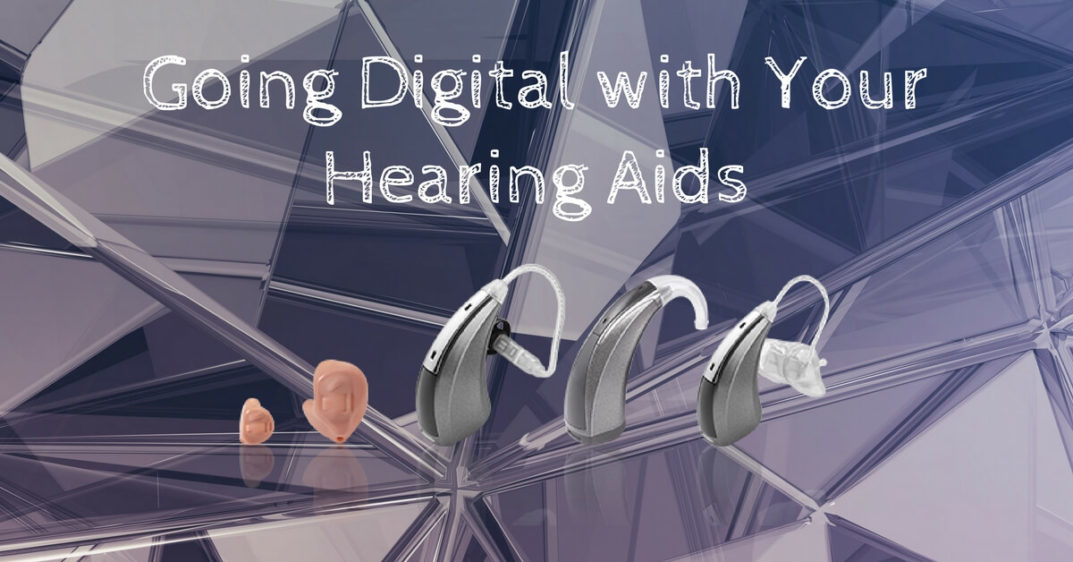Hearing aids have come a long way, baby! Today’s digital hearing aid offerings are literal light years away from those that our grandparents wore. As the entire world around us changes thanks to the computer age, so have our hearing devices. We saw the first fully digitally programmable and processing circuit come onto the market in the mid-nineties. Today, all hearing aids are digital, but to different degrees.
The History of Hearing Aids
Technology has changed so many things about the way we live, ways that were unimaginable to our grandparents or even parents. It’s no surprise that these leaps and bounds of advanced technology have drastically sped up the capabilities of audiology.
Today’s hearing aids would be unrecognizable to those just a few generations past. The first hearing aid that hit the market was actually an ear trumpet. It was a long, tubular instrument that eliminated background noise by focusing on the sound source and amplifying it to the ear. The ear trumpet is extremely low tech by today’s standards!
Radio saves the day
We really have the telephone to thank for the second generation of hearing aids. Radio technology marks the discovery of ways to manipulate and amplify the distortion of sounds. Just before the turn of the 20th century, the first electric hearing aid was developed. Created by Miller Reese Hutchison in 1898, he called the device the Akouphone. Soon after, the Siemens company began manufacturing hearing aids. To this day, Siemens remains a leading manufacturer of hearing aids.
These early modern hearing aids did much to successfully amplify sound compared to that initial ear trumpet. But then again, there was much room for improvement, too. Those first models produced by Siemens were not subtle in the least! They were roughly the size of a cigar box, so even the largest hearing aids on the market today would seem tiny in comparison.
The wearer would have the large receiver strapped to their body and hidden under clothing. Also necessary was an earpiece and a wire connecting the two parts.
Post War boom
Transistors were invented in the late 1940s as a result of advancements made during war efforts. This evolution was actually a revolution and improved the hearing aid offerings by an enormous amount. However perfect the technology was, though, there were some hurdles to overcome once these transistors were worn for extended periods of time on the human body. Issues with dampness and body heat had to be managed by manufacturers and their research and development before being adopted on a large scale.
Digital versus analog
Before the digital boom, all hearing aids were what we refer to as analog technology. What this means is that they work by making continuous sound waves louder by amplifying all sounds without exception. Analog hearing aids are still available today, though they are much less common. Modern analog devices are sometimes programmable, which makes them part digital because they contain a microchip. On this microchip is stored numerous settings for different listening environments. This allows users to switch their hearing aid setting to match the noises that surround them and that they want to hear. For instance, one might want a different setting for a night at the theater versus a crowded restaurant.
The dominance of the digital age
What digital hearing aids do differently is that they do not just amplify any sounds. Instead, they convert sound waves into digital signals. From here, an exact duplication of each sound is produced. Computer chips then analyze the signals, separating them into categories such as speech, music, or background noise or any other classification. The digital hearing aid processes sound in order to deliver to the wearer the clearest and most concise sound information available.
What digital hearing aids do so well is focus in on the sounds you actually want to hear. Their programmable settings are often more varied and subtle than analog hearing aids and can even be adjusted to meet the specific hearing needs of the individual wearer.
Try the digital route
The American Speech-Language-Hearing Association (ASLHA) points to an “explosion of digital hearing aids on the market in the last five years.” Manufacturers have heard the response to these remarkably intuitive digital hearing aids and are providing users with even more options. Make an appointment with an audiologist today to see if digital hearing aids are in your immediate future.
Are you interested in going digital with your hearing aids? Contact us at Comprehensive Ear and Hearing to update to the latest in hearing aid technology.


